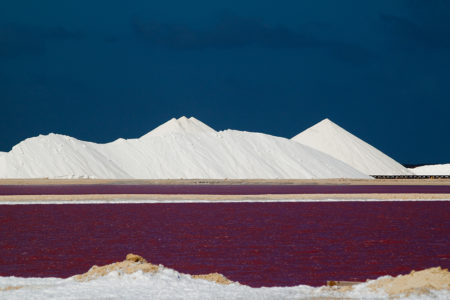
Imagine a vast expanse of rectangular saline ponds in surreal colors – pinks, turquoises, greens – that reach out towards the horizon, flanked by a collection of enormous, immaculately white pyramids of salt. It’s an extraordinary landscape, with an eerie beauty.
Now, there is something even more remarkable about Bonaire’s Cargill Salt Ponds. BirdsCaribbean is excited to share the fantastic news that this important stopover and wintering site for migratory birds has been designated a Western Hemisphere Shorebird Reserve Network (WHSRN) site of Regional Importance. This is the second WHSRN site in the Caribbean, joining the Cabo Rojo Salt Flats in southwestern Puerto Rico. This designation will ensure the protection and management of the site for shorebirds. It’s excellent news for the Red Knot, in particular. In addition to this threatened migratory bird, more than 20,000 shorebirds, representing 17 species, have been recorded at the location.
What is the Western Hemisphere Shorebird Reserve Network?
The Western Hemisphere Shorebird Reserve Network is dedicated to protecting key habitats throughout the Americas, helping sustain healthy populations of shorebirds. With the addition of Cargill Salt Ponds Bonaire, there are now 103 WHSRN sites covering nearly 15 million hectares (38 million acres) in 17 countries. Sites are categorized as having Regional, International or Hemispheric Importance based on the total number of shorebirds they support annually; or if the sites support a substantial percentage of the population of a single species. The new site, the first for the Dutch Caribbean, also lies within BirdLife International’s Important Bird Area (IBA) Pekelmeer Saltworks, Bonaire. This area includes the 400-hectare Pekelmeer Ramsar site (a designation given to Wetlands of International Importance.
The Big Attraction for Shorebirds at Cargill Salt Ponds
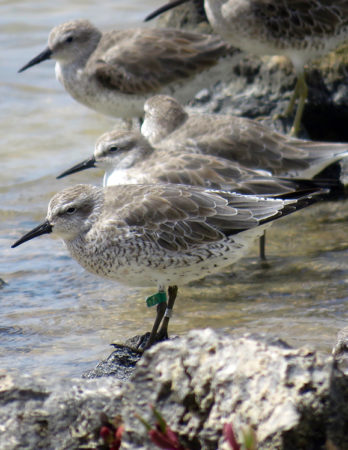
Why do shorebirds thrive at the Salt Ponds? What on Earth could possibly survive in this alien landscape? The answer: brine shrimp and brine flies. These small invertebrates lay the foundation that support thousands of shorebirds annually. Most of them are hungry migrants, taking a much-needed break before continuing on their journey, or spending the winter at this food-rich site. A privately-owned salt production facility at the southern end of Bonaire, owned by Cargill Salt Bonaire B.V., the site comprises 3,700 hectares: 2,700 hectares are artificial wetlands – primarily solar evaporation ponds for salt extraction. Brine shrimp fill the ponds. The dike roads running between the ponds are covered with brine flies. For shorebirds, the shrimp and flies are a delicious food source, right amongst the mountains of salt.
Many are familiar with the extraordinary migratory cycle of the Red Knot: every year, this shorebird flies a roundtrip of close to 19,000 miles, from the Arctic to southern Chile and Argentina. If that wasn’t impressive enough, this bird’s journey includes multi-day stretches (even up to one week!) of continuous flight between stopover sites. These sites that allow the birds to rest and refuel are critically important to the success of the Red Knot’s migration. Without them, this fascinating shorebird would not survive.
Cargill’s Invaluable Support for Shorebird Surveys
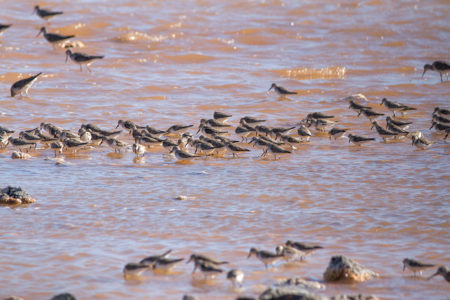
Daniel DeAnda Jr., Cargill’s Production Manager, collaborated with Lisa Sorenson, Executive Director of BirdsCaribbean, on the nomination of the salt ponds for WHSRN status. With Cargill’s support, BirdsCaribbean led surveys, beginning in 2015, to learn more about the species and numbers of birds using the site. Survey results revealed that more than 20,000 shorebirds visit the wetlands annually, qualifying it as a WHSRN site at the “Regional” level of importance. This large concentration of shorebirds includes at least 1% of the biogeographic population of the threatened rufa (American) subspecies of Red Knot (Calidris canutus rufa) and Short-billed Dowitcher.
Unfortunately, shorebird numbers are declining. Some species have seen dramatic and worrying decreases in numbers. The rufa subspecies of the Red Knot has declined 80% over the last 20 years. The population of Semipalmated Sandpiper, which winters on the northern coast of South America, has shown similar declines over 30 years. This is a global problem: The Spoon-billed Sandpiper, which breeds in Russia and winters in Southeast Asia, may have just 100 breeding pairs left. The greatest threats to shorebirds are habitat loss, predators, hunting, and climate change. Areas such as WHSRN sites, which are preserved and protected for shorebirds, are crucial for successful breeding and migration.
BirdsCaribbean and partners recorded 15 other species during the salt pond surveys, including: Semipalmated Sandpiper, Least Sandpiper, Stilt Sandpiper, Semipalmated Plover, and Sanderling. Significant numbers of Snowy Plovers are also found regularly at the location. These are probably a combination of migrants (nominate Charadrius nivosus) and resident birds belonging to the Caribbean breeding subspecies (C. n. tenuirostris). The area is the only known nesting area on Bonaire for the Royal Tern. It also supports one of the most important American Flamingo nesting colonies in the Caribbean.
The Power of Partnerships
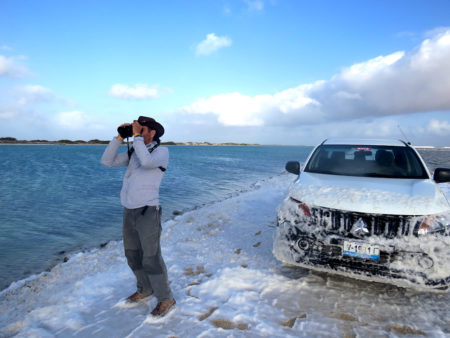
BirdsCaribbean was very fortunate to have motivated and passionate international and local partners, who were essential during the survey periods. The partnership included staff and volunteers from STINAPA Bonaire, WILDSCONSCIENCE, US Fish and Wildlife Service, Cornell Lab of Ornithology, and Dutch Caribbean Nature Alliance. Survey teams led by Fernando Simal (WILDCONSCIENCE) counted birds at 110 points, over five counting periods. Their findings informed the site’s WHSRN designation.
Lisa Sorenson, Executive Director of BirdsCaribbean commented, “We are very grateful for the support we received from Cargill and our partners and volunteers, who enabled us to complete this work. We are especially thankful to Environment and Climate Change Canada for its principal funding support for the surveys, as well as the contribution of the U.S. Forest Service’s Department of International Programs. We also deeply appreciate the encouragement and support we received from Manomet for our nomination.” BirdsCaribbean looks forward to continuing to work together with Cargill and all the partners to monitor and manage the site for shorebirds.
What can we do to help our shorebirds?
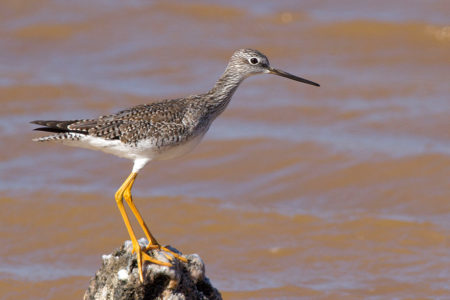
What can we do to help our shorebirds and their habitats? The Caribbean is a key link on the Atlantic Flyway. Its beaches, lagoons, marshes, swamps, rice fields, and other wetlands support enormous numbers of shorebirds annually. In order to ensure shorebird survival and mitigate against ongoing population declines, it is critical to identify and protect important sites in the region. One way you can help is by taking part in the Caribbean Waterbird Census, when professionals as well as citizen scientists count waterbirds during a 3-week period from January 14th to February 3rd as well as other times of year. Read more about shorebirds and the efforts to conserve them through the Atlantic Flyway Shorebird Initiative.
Acknowledgments
BirdsCaribbean thanks Fernando Simal (WILDCONSCIENCE), Jeff Gerbracht (Cornell Lab of Ornithology), Frank Rivera-Milan (US Fish and Wildlife Service) and Lisa Sorenson (BirdsCaribbean) for many hours in the field to survey shorebirds. We also thank the following individuals for field assistance: Paulo Bertoul, Caren Eckrich, Herman Sieben, Elise Lara Galitzki, Diana Sint Jago and Luigi Eybrecht from STINAPA Bonaire, Elly Albers from Bonaire Wild Bird Rehabilitation Center, and Jilly Sarpong (Biology student at HAS University of Applied Sciences in The Netherlands). Dr. Frank Rivera-Milan carried out the data analysis needed to support our nomination of Cargill Salt Ponds as a WHSRN site. Funding support was provided by Environment and Climate Change Canada with additional assistance from the US Forest Service and in-kind support from STINAPA Bonaire, Cargill Salt, STINAPA and Dutch Caribbean Nature Alliance.


















One comment
Comments are closed.